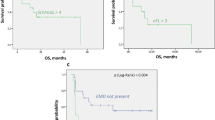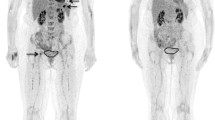Abstract
Purpose
This study investigates the prognostic value of 68Ga-Pentixafor PET/CT using PET-derived quantitative in multiple myeloma (MM) patients with suspected recurrence in comparison to 18F-FDG PET/CT and clinical data.
Methods
Twenty-four MM patients with suspicion for relapse who underwent 68Ga-Pentixafor and 18F-FDG PET/CT were retrospectively evaluated. Total bone marrow glycolysis for 18F-FDG (TBMFDG) and total bone marrow uptake for 68Ga-Pentixafor PET/CT (TBMCXCR4) were calculated using whole-body metabolic tumor burden obtained by dedicated software (MIM 7.0.6). The patients were followed for 19–24 months, and the association of PET-derived quantitative data with overall survival (OS) was analyzed.
Results
68Ga-Pentixafor PET/CT was positive in 17 patients, of which 13 were also positive on 18F-FDG PET/CT, whereas 7 patients were negative on both scans. The positive rate of 68Ga-Pentixafor and 18F-FDG PET/CT on a patient-based approach was 70.8% and 54.1%, respectively. 68Ga-Pentixafor positivity was significantly associated with OS (p = 0.009), and 18F-FDG positivity was at the margin of statistical significance (p = 0.056). TBMCXCR4 and TBMFDG were negatively correlated with OS (r = −0.457, p = 0.025 and r = −0.617, p = 0.001, respectively). The OS was negatively correlated with beta-2-microglobulin levels (r = −0.511, p = 0.01) and CRAB score (r = −0.592, p = 0.002) as an indicator of the end-organ disease, which confirmed these results. Serum beta-2-microglobulin levels and CRAB score were also correlated with TBMCXCR4 (r = 0.442, p = 0.039 and r = 0.573, p = 0.003, respectively) and TBMFDG (r = 0.543, p = 0.009 and r = -0.424, p = 0.003, respectively).
Conclusion
68Ga-Pentixafor PET/CT positivity is a negative prognostic factor in the survival outcome of MM patients. Complementary 68Ga-Pentixafor PET/CT has the potential to overcome 18F-FDG PET/CT limitations and helps a more precise risk stratification.





Similar content being viewed by others
References
Kazandjian D. Multiple myeloma epidemiology and survival: a unique malignancy. Semin Oncol. 2016;43(6):676–81.
Cavo M, Terpos E, Nanni C, Moreau P, Lentzsch S, Zweegman S, et al. Role of 18F-FDG PET/CT in the diagnosis and management of multiple myeloma and other plasma cell disorders: a consensus statement by the International Myeloma Working Group. Lancet Oncol. 2017;18(4):e206–17.
Baffour FI, Glazebrook KN, Kumar SK, Broski SM. Role of imaging in multiple myeloma. Am J Hematol. 2020. https://doi.org/10.1002/ajh.25846.
Kumar S, Paiva B, Anderson KC, Durie B, Landgren O, Moreau P, et al. International Myeloma Working Group consensus criteria for response and minimal residual disease assessment in multiple myeloma. Lancet Oncol. 2016;17(8):e328–46.
Rasche L, Angtuaco E, McDonald JE, Buros A, Stein C, Pawlyn C, et al. Low expression of hexokinase-2 is associated with false-negative FDG-positron emission tomography in multiple myeloma. Blood. 2017;130(1):30–4.
Bao L, Lai Y, Liu Y, Qin Y, Zhao X, Lu X, et al. CXCR4 is a good survival prognostic indicator in multiple myeloma patients. Leuk Res. 2013;37(9):1083–8.
Wester HJ, Keller U, Schottelius M, Beer A, Philipp-Abbrederis K, Hoffmann F, et al. Disclosing the CXCR4 expression in lymphoproliferative diseases by targeted molecular imaging. Theranostics. 2015;5(6):618–30.
Pan Q, Cao X, Luo Y, Li J, Feng J, Li F. Chemokine receptor-4 targeted PET/CT with (68)Ga-Pentixafor in assessment of newly diagnosed multiple myeloma: comparison to (18)F-FDG PET/CT. Eur J Nucl Med Mol Imaging. 2020;47(3):537–46.
Lapa C, Schreder M, Schirbel A, Samnick S, Kortum KM, Herrmann K, et al. [(68)Ga]Pentixafor-PET/CT for imaging of chemokine receptor CXCR4 expression in multiple myeloma - Comparison to [(18)F]FDG and laboratory values. Theranostics. 2017;7(1):205–12.
Kircher M, Herhaus P, Schottelius M, Buck AK, Werner RA, Wester HJ, et al. CXCR4-directed theranostics in oncology and inflammation. Ann Nucl Med. 2018;32(8):503–11.
Lapa C, Herrmann K, Schirbel A, Hanscheid H, Luckerath K, Schottelius M, et al. CXCR4-directed endoradiotherapy induces high response rates in extramedullary relapsed Multiple Myeloma. Theranostics. 2017;7(6):1589–97.
Kuyumcu S, Adalet I, Sanli Y, Turkmen C, Ozkan ZG, Yilmazbayhan D. Somatostatin receptor scintigraphy with 111In-octreotide in pulmonary carcinoid tumours correlated with pathological and 18FDG PET/CT findings. Ann Nucl Med. 2012;26(9):689–97.
Kuyumcu S, Has-Simsek D, Iliaz R, Sanli Y, Buyukkaya F, Akyuz F, et al. Evidence of prostate-specific membrane antigen expression in hepatocellular carcinoma using 68Ga-PSMA PET/CT. Clin Nucl Med. 2019;44(9):702–6.
Moreau P, Attal M, Caillot D, Macro M, Karlin L, Garderet L, et al. Prospective evaluation of magnetic resonance imaging and [18F]Fluorodeoxyglucose positron emission tomography-computed tomography at diagnosis and before maintenance therapy in symptomatic patients with multiple myeloma included in the IFM/DFCI 2009 trial: results of the IMAJEM Study. J Clin Oncol. 2017;35(25):2911–8.
Balkwill F. Cancer and the chemokine network. Nat Rev Cancer. 2004;4(7):540–50.
Kuyumcu S, Yilmaz E, Büyükkaya F, Özkan ZG, Ünal SN. Imaging of chemokine receptor CXCR4 in mycosis fungoides using 68Ga-Pentixafor PET/CT. Clin Nucl Med. 2018;43(8):606.
Philipp-Abbrederis K, Herrmann K, Knop S, Schottelius M, Eiber M, Luckerath K, et al. In vivo molecular imaging of chemokine receptor CXCR4 expression in patients with advanced multiple myeloma. EMBO Mol Med. 2015;7(4):477–87.
Bartel TB, Haessler J, Brown TLY, Shaughnessy JD Jr, van Rhee F, Anaissie E, et al. F18-fluorodeoxyglucose positron emission tomography in the context of other imaging techniques and prognostic factors in multiple myeloma. Blood. 2009;114(10):2068–76.
van Lammeren-Venema D, Regelink JC, Riphagen II, Zweegman S, Hoekstra OS, Zijlstra JM. 18F-fluoro-deoxyglucose positron emission tomography in assessment of myeloma-related bone disease: a systematic review. Cancer. 2012;118(8):1971–81.
Elena Z, Cristina N, Francesca P, Emanuela E, Paolo C, Onelio G, et al. A prospective comparison of 18F-fluorodeoxyglucose positron emission tomography-computed tomography, magnetic resonance imaging and whole-body planar radiographs in the assessment of bone disease in newly diagnosed multiple myeloma. Haematologica. 2007;92(1):50–5.
Rasche L, Kortum KM, Raab MS, Weinhold N. The impact of tumor heterogeneity on diagnostics and novel therapeutic strategies in multiple myeloma. Int J Mol Sci. 2019;20(5):1248.
Jamet B, Bailly C, Carlier T, Touzeau C, Nanni C, Zamagni E, et al. Interest of pet imaging in multiple myeloma. Front Med. 2019;6:69.
Mesguich C, Zanotti-Fregonara P, Hindie E. New perspectives offered by nuclear medicine for the imaging and therapy of multiple myeloma. Theranostics. 2016;6(2):287–90.
Elliott BM, Peti S, Osman K, Scigliano E, Lee D, Isola L, et al. Combining FDG-PET/CT with laboratory data yields superior results for prediction of relapse in multiple myeloma*. Eur J Haematol. 2011;86(4):289–98.
Usmani SZ, Mitchell A, Waheed S, Crowley J, Hoering A, Petty N, et al. Prognostic implications of serial 18-fluoro-deoxyglucose emission tomography in multiple myeloma treated with total therapy 3. Blood. 2013;121(10):1819–23.
Varettoni M, Corso A, Pica G, Mangiacavalli S, Pascutto C, Lazzarino M. Incidence, presenting features and outcome of extramedullary disease in multiple myeloma: a longitudinal study on 1003 consecutive patients. Ann Oncol. 2010;21(2):325–30.
Stessman HA, Mansoor A, Zhan F, Janz S, Linden MA, Baughn LB, et al. Reduced CXCR4 expression is associated with extramedullary disease in a mouse model of myeloma and predicts poor survival in multiple myeloma patients treated with bortezomib. Leukemia. 2013;27(10):2075–7.
Weinstock M, Aljawai Y, Morgan EA, Laubach J, Gannon M, Roccaro AM, et al. Incidence and clinical features of extramedullary multiple myeloma in patients who underwent stem cell transplantation. Br J Haematol. 2015;169(6):851–8.
Acknowledgements
The authors thank Prof. Dr. Hans-Jürgen Wester for his support. The authors thank Istanbul Development Agency for their support in the theranostic research infrastructure of our department and radiopharmacy laboratory
Funding
The authors disclose that they did not receive any personal or financial support for this study.
Author information
Authors and Affiliations
Corresponding author
Ethics declarations
Conflict of interest
The authors declare no conflict of interest.
Ethical approval
All procedures performed in studies involving human participants were in accordance with the ethical standards of the institutional and/or national research committee and with the 1964 Declaration of Helsinki and its later amendments or comparable ethical standards.
Informed consent
Informed consent was obtained from all patients included in the study.
Additional information
Publisher's Note
Springer Nature remains neutral with regard to jurisdictional claims in published maps and institutional affiliations.
Supplementary Information
Below is the link to the electronic supplementary material.
12149_2021_1652_MOESM1_ESM.png
Supplementary Fig. 1 18F-FDG and 68Ga-Pentixafor-PET maximum intensity projection images showing tumor burden of patient #24 obtained using dedicated software (MIM 7.0.6 Lesion ID) for segmentation (PNG 455 KB)
Rights and permissions
About this article
Cite this article
Kuyumcu, S., Isik, E.G., Tiryaki, T.O. et al. Prognostic significance of 68Ga-Pentixafor PET/CT in multiple myeloma recurrence: a comparison to 18F-FDG PET/CT and laboratory results. Ann Nucl Med 35, 1147–1156 (2021). https://doi.org/10.1007/s12149-021-01652-1
Received:
Accepted:
Published:
Issue Date:
DOI: https://doi.org/10.1007/s12149-021-01652-1




